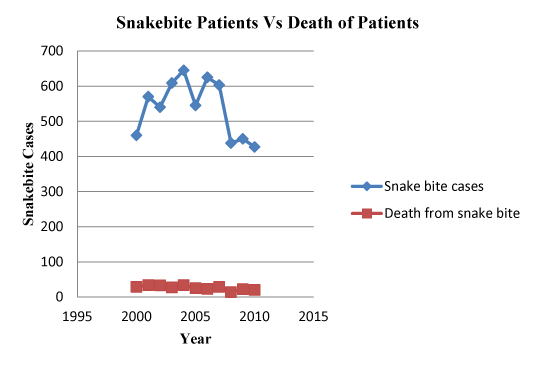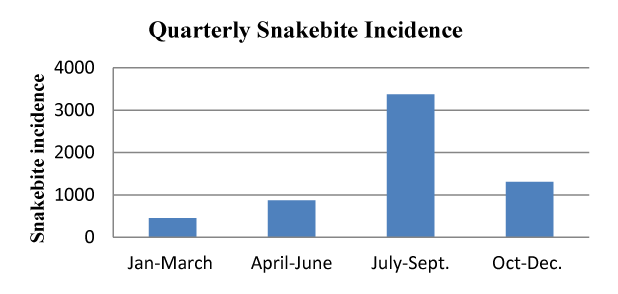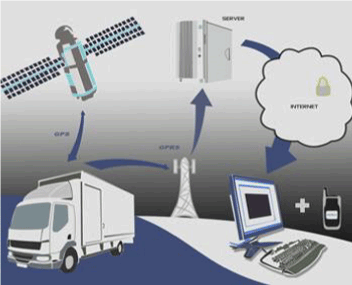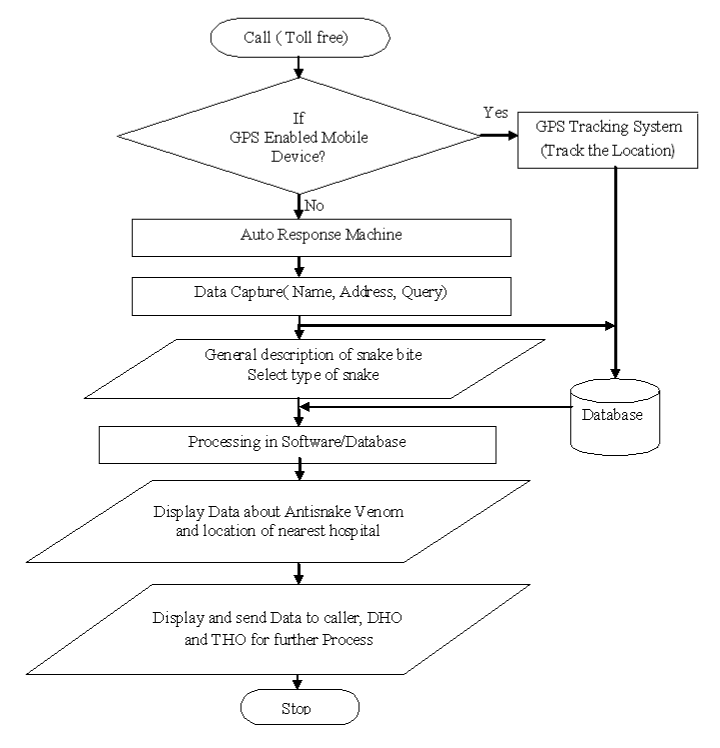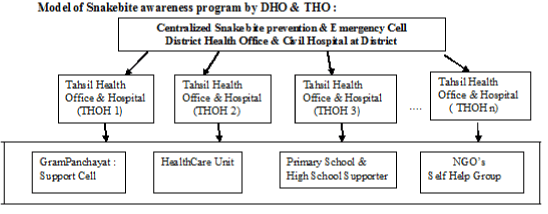| Research Article |
Open Access |
|
| PP Patil1, Abhijit A Patil1* and BT Jadhav2 |
| 1Associate Proffesor, Bharati vidyapeeth, Deemed University, YMIM, Karad |
| 2Associate Proffesor, Department of Electronics & Computer Science, KBP, YC college of Science, Satara |
| *Corresponding authors: |
Abhijit A Patil
Assistant Proffesor, Bharati vidyapeeth
Deemed University, YMIM, Karad
E-mail: abhijitpatil33@yahoo.com |
|
| |
| Received February 03, 2012; Published August 24, 2012 |
| |
| Citation: Patil PP , Patil AA, Jadhav BT (2012) GPS Technology in Service of Society: A Case Study of Snakebite. 1: 248. doi:10.4172/scientificreports.248 |
| |
| Copyright: © 2012 Patil PP , et al. This is an open-access article distributed under the terms of the Creative Commons Attribution License, which permits unrestricted use, distribution, and reproduction in any medium, provided the original author and source are credited. |
| |
| Abstract |
| |
| Information and communication System plays an important role in the lives of affected Patients of snakebites. The information systems can be developed which may help to the mankind in emergency by transferring data. The paper explains the present scenario of Snake bite patients status in the selected sensitive area in the rural Maharashtra. Survey shows that, the worst picture of lack of communication system for assistance to the affected patients and their further treatment by the hospitals. The paper suggests the Global Positioning System (GPS) Enabled computing model and the usage of Wireless Technology. The literature survey shows that, such model may be the need in snake bite affected areas. The Computing model based on the wireless technology is also useful for making awareness by sharing the information about the prevention of snake bites and the treatments as first Aid to the community and how does the data about the victim can be made available and communicated to the further centers such as hospitals. We mentioned here the advantages and the limitations of the proposed computing model. This is an attempt for the use of Information Communication Technology (ICT) to inculcate the awareness about prevention of snakebite and treatment. |
| |
| Keywords |
| |
| GPS; Information System; Wireless Communication; Computing Model; ICT; Prevention of Snakebite; Community |
| |
| Introduction |
| |
| Snakebite is an important and serious problem in rural Maharashtra. It is found that there is no proper reporting system due to lack of use of information and communication facility to report about the snakebite victim for in time treatment. It has been observed that the deaths due to snake bite are occurred even in the presence of advanced communication technology. It is due to lack of in time treatment of the patients. Whenever any patient is bitten by the animal like snake in the rural area, it is seen that most of the cases are dead due to lack of communication between patient and treatment system i.e. hospitals. This paper focus on the use of ICT in snakebite cases in rural Maharashtra. We evaluate that the snakebite cases admitted and referred for higher hospitals due to the unavailability of anti snake venom (ASV) that would increase the chances of uncertainty. The paper suggests a proposed computing model to help and report the location and the timely availability of the anti snake venom. |
| |
| Materials and Methods |
| |
| India having 216 species of snakes out of that only 52 species are poisonous. The time interval between snakebite and initiation of treatment is more than 6 hrs. Public Health Care centers limits the communication and information tools of IT Infrastructure. Our research target is to provide the snakebite information to the Hospital & avail services to the victims & villagers directly through mobile communication system. |
| |
| Materials |
| |
| Following snakebite sample cases were collected and studied from the Department of the Dr Shankarrao Chavan Government Medical College and Hospital, Vazirabad, Nanded District, Maharashtra State, India. (Table 1,2 & Chart 1,2). |
| |
|
|
Table 1: Snake bites cases per year from 2000-2010. |
|
| |
|
|
Table 2:Quarterly Snake bite Incidence in 2000-2010 yrs. |
|
| |
|
|
Chart 1: Snakebite Patients Vs Death. |
|
| |
|
|
Chart 2: Quarterly snakebite incidence. |
|
| |
| Methods |
| |
| Proposed computing model for treatment of snake bites: |
| |
| • Internal Mechanism of RAC (Rural Assistance Center) Computing System: Incoming call (toll free call) coming from GPS enabled handset to RAC computing system is handled by GPS Tracking system to track the location otherwise handled by auto response machine to capture the name ,address, query information and store into the database (Figure 1). A software based on the knowledge management, accept the general description of snakebite to find out the type of snakebite and after further processing it display the data about the antisnake venom and nearest location of the hospital to get the treatment. This data forwarded to the caller, District Health Office (DHO) and Tahsil Health Office (THO) for further processing to get in time treatment to save the life of snakebite victim (Figure 2-4). |
| |
|
|
Figure 1: GPS Tracking System. |
|
| |
|
|
Figure 2: Flow diagram: Internal working of RAC Computing System. |
|
| |
|
|
Figure 3: Developing awareness among the population through RAC (Rural Assistance Center). |
|
| |
|
|
Figure 4: Interactions between Rural Assistance Center (RAC) units.. |
|
| |
| • Working: Rural Assistance Center (RAC) is one of the GPS and Web based information cell which shares the information about snakebite prevention programmes and awareness amongst the local users about snakebites and its adverse impact communicated through using ICT based Wireless Computing Model. |
| |
| RAC interact with the following units |
| |
| i) Local Self Help Group |
| |
| ii) Farmers |
| |
| iii) Grampanchayat |
| |
| iv) Emergency Services and Ambulance |
| |
| v) Victims: Affected Users |
| |
| vi) Local Teachers and Volunteers |
| |
| vii) District & Tahsil Administration |
| |
| viii) Research Institutions |
| |
| GPS Enabled RAC comprises a web based Computing Information Systems which is a combination of two heterogeneous technologies viz. Information Communication Technology (ICT) and Medical Technology (MT). RAC must work under the control of Regional Healthcare Center in association with the above mentioned components. |
| |
| Roles and responsibilities of RAC units |
| |
| Local self help group: The local self help group must be trained with the primary treatment (First Aid ) given after the snakebite immediately. The Local self help group should contain two senior women members, two farmers and a snake friend as a young farmer. The Regional Health Center in association with research institution and district and Tahsil administration should provide the training of this computing system and give the updated information to the local self help group through RAC. When any snakebite incident happens then a member of Local Self Help Group should be use this system and informed so that in emergency |
| |
| Farmers: The farmers should be aware by the RAC with the help of Gramapanchyat Authority and Trained Teacher through Awareness Programme about Prevention of Snake bite and First Aid Treatment through Web application of RAC. These trained farmers should convey and share these information and precautions amongst the community. The RAC should display the important and Emergency mobile numbers of close by and local hospitals which provide treatment of Snake bite affected patients. In emergency the farmer should contact the above said emergency numbers and follow their instructions. |
| |
| Grampanchyat: The Grampanchyat authority (GRamsevek – Govt. Officio) should display the pictorial information prevention and types of snakes and basic First Aid Treatments through posters. Conduct awareness Programmes with the help of School and High Trained Teachers to the students as well as farmers in the village through interacting with the RAC system |
| |
| Emergency Services and Ambulance (ESA): Emergency Services (ESA) should be made available by Civil Surgeon through Medical Officer at closet Primary Health Center. They should display about various types of Snakes and their Symptoms. They should have 24x7x366 emergency ambulance service which will work with RAC computing system through Wireless Technology. The Ambulance should be well equipped with few support of Antisnake venom. When the Emergency cell receives any phone call or instruction from RAC computing system about snakebite patient then it is their responsibility to follow the case and support to the victim so as to save the life. |
| |
| • Victims: affected person: Victims or Relatives should just dial the toll free number of RAC Computing system and follow the instruction and use the data and information given by the RAC Computing System. |
| |
| • District & Tahsil health administration: District Health Administration has to establish the Emergency Cell regarding the Snake bite treatments through Tahsils in association with the Medical Research Institutions and Private Hospitals. It is now the Tahsil Health Administration who should also plan and execute the instructions received from the District for the prevention and treatment of snakebite patients in the villages. RAC computing system should be controlled by the Regional Health and District Health Administration by providing the updating medical information related to antisnake venom. |
| |
| • Research institutions: The Research institutions has to share the Innovative information about prevention and First aid treatments, post medical treatments by making the use of locally available resources and advanced technology. Research Institutions must provide the information about advanced medicines (Antisnake venom) to the RAC and update it regularly. |
| |
| Summary |
| |
| It has been concluded that the GPS enabled proposed computing model based on wireless technology will be useful to the snakebite victims and society to save the life by providing the accurate and faster information of antisnake venom and nearest location of the hospital. This Paper Shows following advantages: |
| |
| • In time reporting of snakebite victim |
| |
| • Quick & accurate information available about antisnake venom stock and the location of nearest hospital for treatment |
| |
| |
| • Emergency ambulance and services are available through this system |
| |
| • Required report generated and Easy to use |
| |
| • Helps to aware about prevention of snakebite & its treatment |
| |
| • Highly useful to the rural community |
| |
| The Paper shows some Limitations in the above System |
| |
| • Regular data updating is required |
| |
| • High bandwidth will gives better & faster results |
| |
| High bandwidth communication system throughout the world makes it possible to implement this computing system model nationwide and worldwide in the service of society. |
| |
| |
| References |
| |
- DP Punde (2005) Management of snake bite in Rural Maharashtra. National Medical Journal of India 18: 71-75.
- IF Inamdar, NR Aswar, M Ubaidula, SD Dalvi (2010) Snake bite: Admissions at a Teritary healthcare center in Maharrashtra, India. S Afr Med J 100: 456-458.
- Bawaskar HS, Bawaskar PH (2002) Profile of snakebite envenoming in western Maharashtra, India”. Trans R Soc Trop Med Hyg 96: 79-84.
- David A Warrell (1999) Guidelines for the Clinical Management of Snake Bite in the South-East Asia Region” SEAMEOTROPMED, WHO, Southeast Asian J Trop Med Public Health 30: 1-85.
- Virendra C Patil, Harsha V Patil, Avinash Patil, Vaibhav Agrawal (2011) Clinical Profile and outcome of envenomous snake-bite at tertiary care centre in western Maharashtra. International Journal of Medicine and Public Health 1: 28-38.
- Ruchika Gupta, BVR Reddy (2011) GPS and GPRS Based cost effective human tracking system using mobile phones VIEWPOINT.
- Khondker Shajadul Hasan, Mashiur Rahman (2009) Cost Effective GPS-GPRS Based Object Tracking System. IMECS 1: 18-20.
- Yusn G, Zhang Z, Wei Shang Guan (2006) Research and Design of GIS in vehicle monitoring system. Proceedings of IEEE.
- Brahim G, Luigi L (2000) Understanding GPRS: The GSM Packet Radio Service. Computer Networks 34: 763-779.
- www.gpsspying.com
- www.gpsgate.com
|
| |
| |

